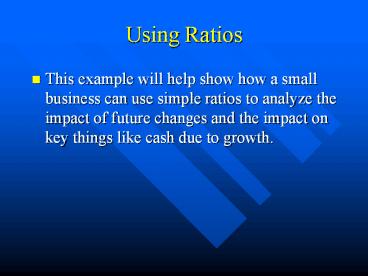Using Ratios - PowerPoint PPT Presentation
1 / 16
Title:
Using Ratios
Description:
Using Ratios. This example will help show how a small business can use simple ratios to ... Let's assume that the business will maintain operations similar to ... – PowerPoint PPT presentation
Number of Views:17
Avg rating:3.0/5.0
Title: Using Ratios
1
Using Ratios
- This example will help show how a small business
can use simple ratios to analyze the impact of
future changes and the impact on key things like
cash due to growth.
2
Company Information
- Sales
- Average A/R
- Gross Profit
- Average Inventory
- Annual Overhead
- 750,000
- 125,000
- 275,000
- 145,000
- 205,000
3
Question 1
- What is the average collection period ratio for
this business?
4
Answer
- First we need the Receivables Turnover ratio
(credit sales/average A/R) - 750,000/125,000 (assuming all sales are credit)
- Receivables Turnover 6 times
- Then we divide the of days in their accounting
period by the Receivables Turnover ratio - 365/6 61
5
Question 2
- What if Meades average collection period
improves by 5 days, what will be the impact on
cash flow? - Is there enough information to answer this
question? - Where would you start?
6
Answer
- The new average collection period56 days
- Now we have to work backwards their collection
period is how quickly their customers pay them,
so if they get paid in 56 days, their Receivables
Turnover is 6.5 times (365/56). Now what?
7
Changes
- What 2 things could change to get this new ratio?
- Average Accounts Receivable
- Credit Sales
- Which one sounds like the best choice for an
improvement in collection? - I would opt for A/R we dont know anything
about sales improving, only that people are
paying them on a more timely basis.
8
Results
- Now we can work out some new numbers. If sales
are constant and we have a new Receivables
Turnover Ratio, we can arrive at the following - Sales (750,000)/Avg. AR 6.5
- Avg. A/R 115,384.61
- On average, they have an additional 10,000 of
cash on hand to use for the operation of the
business!!
9
Question 3
- If sales increase by 10, what will be the
impact on A/R?
10
Assumptions
- Lets assume that the business will maintain
operations similar to the point before the
increase. - Then all that needs to be done is to determine
the ratio of A/R to sales.
11
Results
- Sales
- Avg. A/R
- Rec. Turnover Ratio
- Sales (10 increase)
- Avg. A/R
- Rec. Turnover Ratio
- 750,000
- 125,000
- 6
- 825,000
- 137,500
- 6
12
Question 4
- If sales increase by 10, what will be the impact
on inventory?
13
Process
- We can use the same process as before, just
different numbers. - A good approach would be to keep the ratio of
inventory to sales constant, here are the results.
14
Results
- Sales
- Avg. Inventory
- Ratio Inv/Sales
- Sales (10 increase)
- Avg. Inventory
- Ratio Inv/Sales
- 750,000
- 145,000
- 0.19333333
- 825,000
- 159,500
- 0.19333333
15
Another Approach
- We can also look at keeping the inventory
turnover ratio constant. Inventory turnover is
Cost of Goods Sold divided by Avg. Inventory - COGS (475,000)/Avg. Inv.(145,000)3.27586
- If sales increase 10 and we want to keep this
ratio constant, we need to update the COGS (keep
it at the same of sales) and then determine the
new inventory level.
16
Results
- COGS (as of sales)
- Sales (10 increase)
- COGS
- Avg. Inventory
- Inv. Turnover ratio
- 0.63333333
- 825,000
- 522,500
- 159,500
- 3.27586































